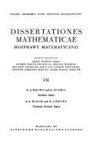模空间$\mathcal M_{0,n+3}$上的遗忘映射诱导有理曲线的$(n+3)$-网
IF 0.8
3区 数学
Q1 MATHEMATICS
引用次数: 2
摘要
我们讨论了由$n+3$遗忘映射$\mathcal M_{0,n+3}\rightarrow \mathcal M_{0,n+2}$定义的$\mathbf P^1$上的$n+3$点的投影位形的模空间$\mathcal M_{0,n+3}$上的曲线web $\boldsymbol{\mathcal W}_{0,n+3}$。我们回想一下经典的结果,这些结果表明当$n$为奇数时,这个网络是线性的,或者当$n$为偶数时,它等价于一个由圆锥组成的网络。然后我们转向这些网络的阿贝尔关系(ARs)。在回顾了众所周知的情况下$n=2$(涉及到五项功能同一性的二对数),我们关注6 web的情况$\boldsymbol{\mathcal W}_{{0,6}}$。我们证明了这个网与Segre的三次原$\boldsymbol{S}\subset \mathbf P^4$中包含的线构成的网是同构的,并且证明了一种“Abel定理”允许用$\boldsymbol{S}$中包含的线的Fano曲面$F_1(\boldsymbol{S})\subset G_1(\mathbf P^4)$上的abelian 2-form来描述$\boldsymbol{\mathcal W}_{{0,6}}$的ar。由此我们推导出$\boldsymbol{\mathcal W}_{{0,6}}$在其所有有理数下具有极大秩,并且它们张成一个不可约的$\mathfrak S_6$ -模空间。然后我们采用Damiano的一种方法,当$n$是奇数时,我们纠正了这种方法:它导致对$\boldsymbol{\mathcal W}_{0,n+3}$的ar空间的抽象描述为$\mathfrak S_{n+3}$ -表示。特别地,我们得到了这个网站对于任何$n\geq 2$都有最大的排名。最后,我们考虑了由Damiano利用多对数形式的Gelfand-MacPherson理论从$\mathbf R^{n+3}$的2平面的grassmannian上的一个特征类构造的$\boldsymbol{\mathcal W}_{0,n+3}$的特殊AR“Euler’s abelian关系$\boldsymbol{\mathcal E}_n$”。我们给出了一个明确的推测公式$\boldsymbol{\mathcal E}_n$的组成部分,我们证明了$n\leq 12$是正确的。本文章由计算机程序翻译,如有差异,请以英文原文为准。
On the $(n+3)$-webs by rational curves induced by the forgetful maps on the moduli spaces $\mathcal M_{0,n+3}$
We discuss the curvilinear web $\boldsymbol{\mathcal W}_{0,n+3}$ on the moduli space $\mathcal M_{0,n+3}$ of projective configurations of $n+3$ points on $\mathbf P^1$ defined by the $n+3$ forgetful maps $\mathcal M_{0,n+3}\rightarrow \mathcal M_{0,n+2}$. We recall classical results which show that this web is linearizable when $n$ is odd, or is equivalent to a web by conics when $n$ is even. We then turn to the abelian relations (ARs) of these webs. After recalling the well-known case when $n=2$ (related to the 5-terms functional identity of the dilogarithm), we focus on the case of the 6-web $\boldsymbol{\mathcal W}_{{0,6}}$. We show that this web is isomorphic to the web formed by the lines contained in Segre's cubic primal $\boldsymbol{S}\subset \mathbf P^4$ and that a kind of `Abel's theorem' allows to describe the ARs of $\boldsymbol{\mathcal W}_{{0,6}}$ by means of the abelian 2-forms on the Fano surface $F_1(\boldsymbol{S})\subset G_1(\mathbf P^4)$ of lines contained in $\boldsymbol{S}$. We deduce from this that $\boldsymbol{\mathcal W}_{{0,6}}$ has maximal rank with all its ARs rational, and that these span a space which is an irreducible $\mathfrak S_6$-module. Then we take up an approach due to Damiano that we correct in the case when $n$ is odd: it leads to an abstract description of the space of ARs of $\boldsymbol{\mathcal W}_{0,n+3}$ as a $\mathfrak S_{n+3}$-representation. In particular, we obtain that this web has maximal rank for any $n\geq 2$. Finally, we consider `Euler's abelian relation $\boldsymbol{\mathcal E}_n$', a particular AR for $\boldsymbol{\mathcal W}_{0,n+3}$ constructed by Damiano from a characteristic class on the grassmannian of 2-planes in $\mathbf R^{n+3}$ by means of Gelfand-MacPherson theory of polylogarithmic forms. We give an explicit conjectural formula for the components of $\boldsymbol{\mathcal E}_n$ that we prove to be correct for $n\leq 12$.
求助全文
通过发布文献求助,成功后即可免费获取论文全文。
去求助
来源期刊
CiteScore
2.80
自引率
0.00%
发文量
8
审稿时长
>12 weeks
期刊介绍:
DISSERTATIONES MATHEMATICAE publishes long research papers (preferably 50-100 pages) in any area of mathematics. An important feature of papers accepted for publication should be their utility for a broad readership of specialists in the domain. In particular, the papers should be to some reasonable extent self-contained. The paper version is considered as primary.
The following criteria are taken into account in the reviewing procedure: correctness, mathematical level, mathematical novelty, utility for a broad readership of specialists in the domain, language and editorial aspects. The Editors have adopted appropriate procedures to avoid ghostwriting and guest authorship.

 求助内容:
求助内容: 应助结果提醒方式:
应助结果提醒方式:


